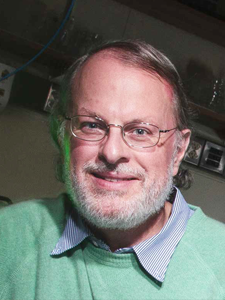Geissinger, Peter
Education
Ph.D., University of Bayreuth, Germany
Research Areas
Intermolecular Interactions in Solids at a Microscopic Level
The research interests of my group fall into two main areas:
- The study of intermolecular interactions in solids at a microscopic level with the goal of determining quantities like electric fields the are generated by the local environment of a probe molecule at the probe molecule site;
- The use optical fibers as support for combinatorial chemistry, with applications ranging from the design of new drugs to the efficient synthesis and spatially resolved, remote readout of large, diverse array of optical fiber sensors.
To study molecular interactions at such a level of detail, we are employing state-of-the-art laser spectroscopic methods (such as hole-burning spectroscopy) to probe transitions between electronic states of probe molecules in host materials of interest (e.g. proteins, molecular crystals) and to determine how the transitions are affected by the interaction with their environment. In particular, we are interested in determining quantitatively the electric fields that are generated at the site of the probe molecules by the charge distributions of the surrounding host molecules. Knowledge of these fields is of major importance particularly in biological systems, where internal fields can be key determinants in processes involving charge separation and transport (e.g. photosynthetic reaction center) and can also determine ligand discrimination (e.g. myoglobin, hemoglobin). Related work is performed within UW-Milwaukee's interdisciplinary research center, the Laboratory for Surface Studies.
Some specific projects are:
- Internal electric determination in heme proteins
In a first step we were able to determine internal electric fields at the site of the heme in myoglobin and cytochrome c in molecular resolution. The next step is to increase the resolution to the atomic level, which will yield internal electric field values for each of the atoms of the probe molecule. The result is an electric field map of the heme cavity of the protein.
- Investigation of the dependence of internal electric fields on pressure induced structural changes
The application of external pressure changes the positions of the host molecules with respect to the probe molecule. This, in turn, influences the internal electric field at the probe molecule site. Measuring the pressure dependence of the internal field will provide a means for refining the models used in the electric field determination. Furthermore, from the pressure-dependence of the transition energies of the dopant molecules, the compressibility of the local environment of the probe molecule can be calculated.
Fiber-Optic Combinatorial Chemistry
The second focus area of our research is based on our "Fiber-Optic Combinatorial Chemistry" technique, which combines combinatorial synthesis and optical fiber sensor technologies. This work is done in close collaboration with the group of my colleague, Prof. Alan W. Schwabacher, who introduced a novel combinatorial chemistry method that relies on linear supports. With this one-dimensional combinatorial chemistry method, we are in a position to synthesize libraries of compounds with thousands of members in the cladding of optical fibers. When these compound libraries are assayed for a desired property using the binding of fluorescent tags as markers for positively identified library members, in effect, a fluorescent fiber sensor array is created. Laser pulses propagating down the fiber core probe the cladding for the presence of fluorescent groups. After excitation, the subsequent fluorescence pulse is propagates back to the front end of the fiber, where it is detected. From the time delay between exciting and returning pulse, the location of the emitting molecule is calculated. It is a virtue of our combinatorial synthetic procedure that with the location of a compound on the fiber, its synthetic history is immediately known. With our technique, compound libraries on optical fibers can be synthesized for many different purposes, ranging from the design of new drugs to the fabrication of linear optical fiber sensor arrays for a multitude of sensing tasks, from the screening of medical analytes to the monitoring of pollutants in the environment.
Some specific projects are:
- Overcoming limitations on the spatial resolution
In order to resolve the fluorescence pulses from adjacent fluorescent regions on a fiber, a minimum separation has to be maintained. The spatial resolution can be improved dramatically through the use of a second fiber, which couples to the first one only through the evanescent fields of the light modes, as an optical delay. We are continuing to study the properties of this coupling scheme and to determine the optimum parameters for the various possible applications our "Fiber-Optic Combinatorial Chemistry" method.
- Development of a potable water monitoring system
Within the Center for Water Security, which was established with support of the United States Congress at UW-Milwaukee, we are developing a fiber-optic monitoring system for municipal potable water distribution systems. The goal is use our "Fiber-Optic Combinatorial Chemistry" method to created optical fibers that monitor potable water during its distribution for the presence of harmful agents. Since the readout is spatially resolved, the location of harmful substance is immediately known, allowing for rapid and targeted countermeasures. These research projects integrate challenging experimental and theoretical work. Students gain broad experience in a variety of fields such as optical (laser) spectroscopy, laser physics, cryo and vacuum technology, as well as molecular modeling.
